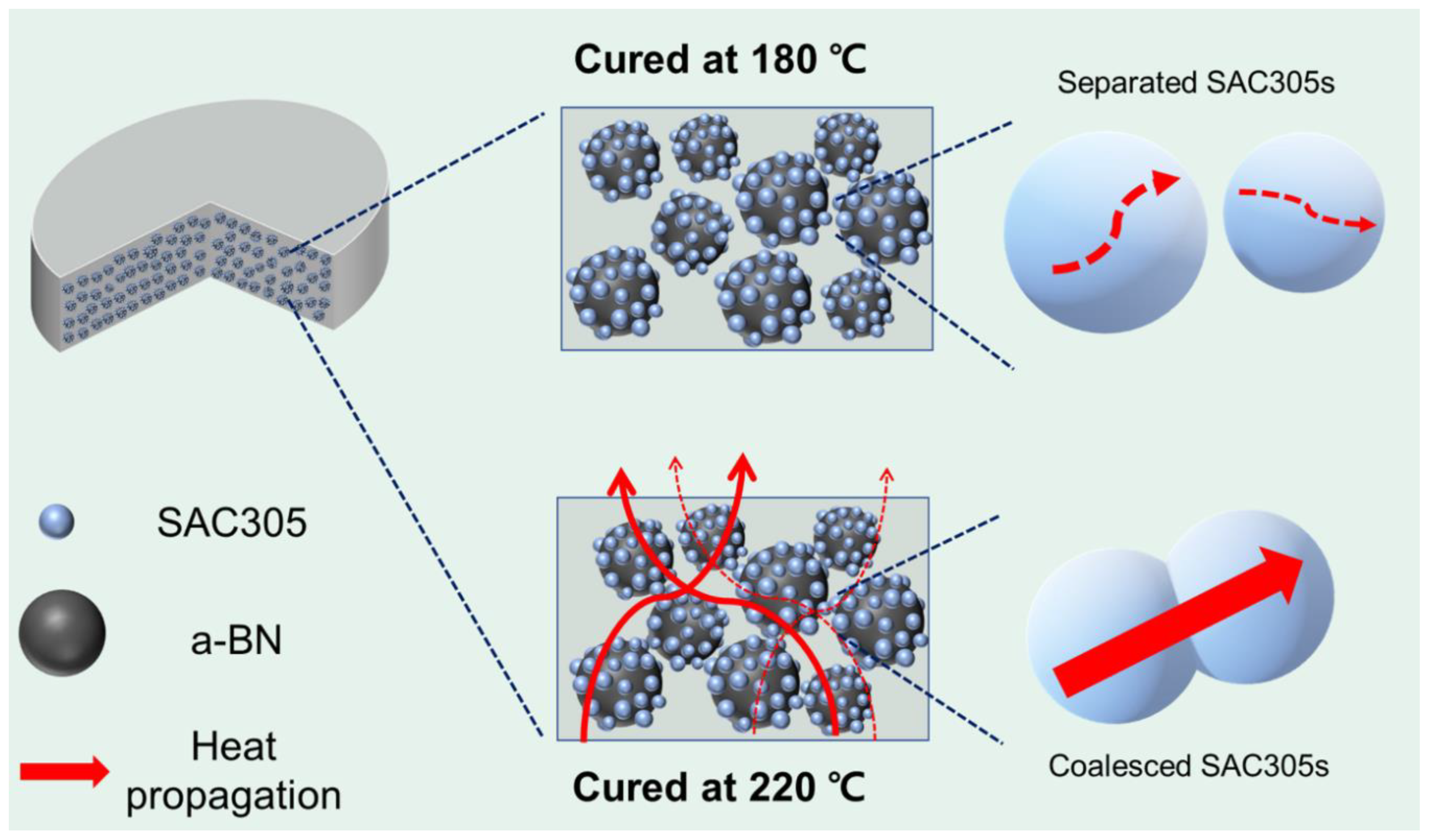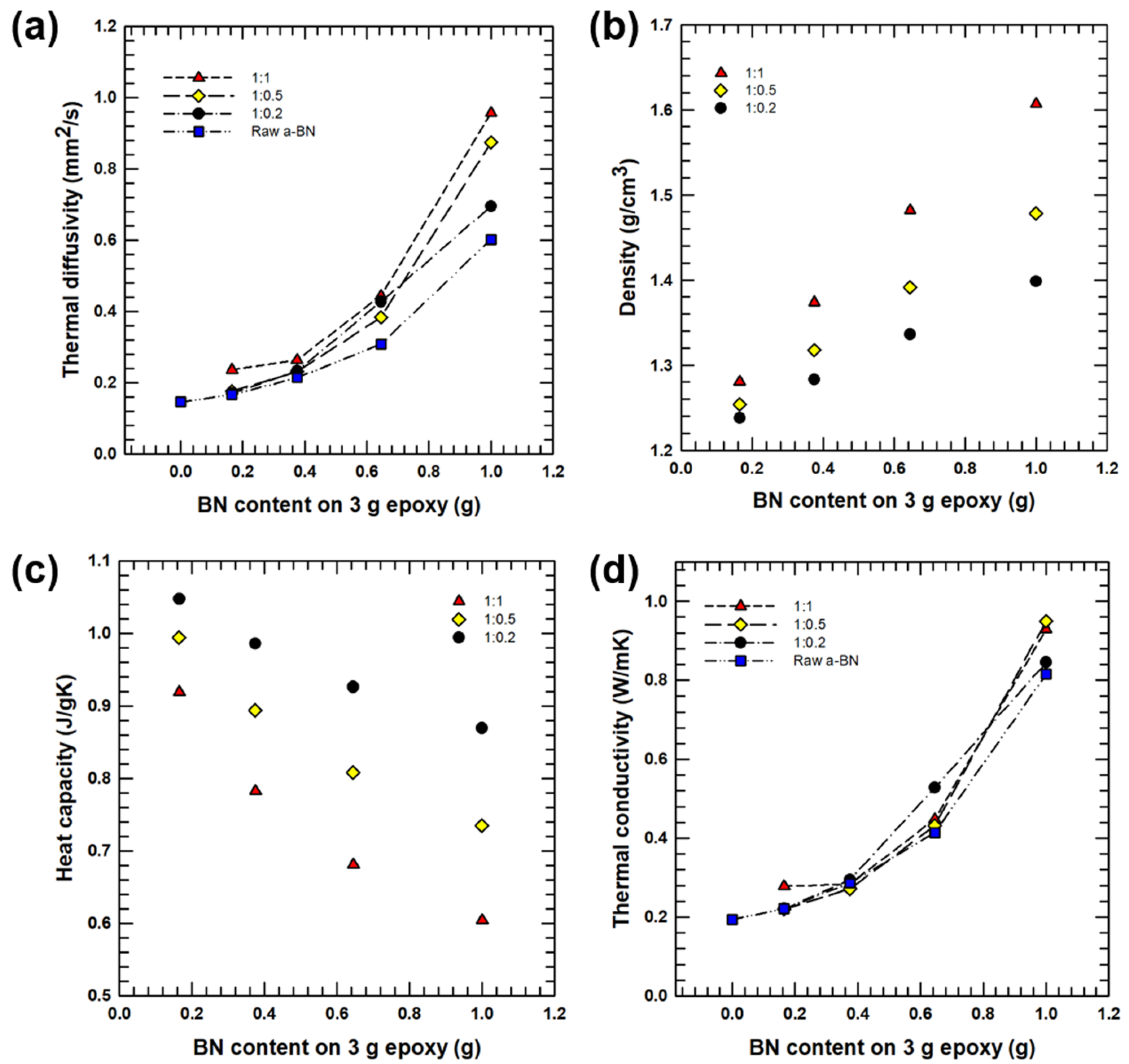3D Interconnected Boron Nitride Networks in Epoxy Composites via Coalescence Behavior of SAC305 Solder Alloy as a Bridging Material for Enhanced Thermal Conductivity
Abstract
1. Introduction
2. Experimental
2.1. Materials
2.2. Preparation of a-BN/SAC305 Hybrid Filler
2.3. Fabrication of Epoxy Composite Filled with a-BN/SAC305 Hybrid Filler
2.4. Characterization
3. Results and Discussion
4. Conclusions
Supplementary Materials
Author Contributions
Funding
Conflicts of Interest
References
- Ouyang, Y.; Ding, F.; Bai, L.; Li, X.; Hou, G.; Fan, J.; Yuan, F. Design of network Al2O3 spheres for significantly enhanced thermal conductivity of polymer composites. Compos. Part. A Appl. Sci. Manuf. 2020, 128, 105673. [Google Scholar] [CrossRef]
- Guo, Y.; Ruan, K.; Shi, X.; Yang, X.; Gu, J. Factors affecting thermal conductivities of the polymers and polymer composites: A review. Compos. Sci. Technol. 2020, 193, 108134. [Google Scholar] [CrossRef]
- Zhao, L.; Shi, X.; Yin, Y.; Jiang, B.; Huang, Y. A self-healing silicone/BN composite with efficient healing property and improved thermal conductivities. Compos. Sci. Technol. 2020, 186, 107919. [Google Scholar] [CrossRef]
- Huang, C.; Qian, X.; Yang, R. Thermal conductivity of polymers and polymer nanocomposites. Mater. Sci. Eng. R Rep. 2018, 132, 1–22. [Google Scholar] [CrossRef]
- Zhang, T.; Sun, J.; Ren, L.; Yao, Y.; Wang, M.; Zeng, X.; Sun, R.; Xu, J.-B.; Wong, C.-P. Nacre-inspired polymer composites with high thermal conductivity and enhanced mechanical strength. Compos. Part. A Appl. Sci. Manuf. 2019, 121, 92–99. [Google Scholar] [CrossRef]
- Yuan, H.; Wang, Y.; Li, T.; Wang, Y.; Ma, P.; Zhang, H.; Yang, W.; Chen, M.; Dong, W. Fabrication of thermally conductive and electrically insulating polymer composites with isotropic thermal conductivity by constructing a three-dimensional interconnected network. Nanoscale 2019, 11, 11360–11368. [Google Scholar] [CrossRef]
- Xiao, C.; Chen, L.; Tang, Y.; Zhang, X.; Zheng, K.; Tian, X. Three dimensional porous alumina network for polymer composites with enhanced thermal conductivity. Compos. Part. A Appl. Sci. Manuf. 2019, 124, 105511. [Google Scholar] [CrossRef]
- Barani, Z.; Mohammadzadeh, A.; Geremew, A.; Huang, C.Y.; Coleman, D.; Mangolini, L.; Kargar, F.; Balandin, A.A. Thermal properties of the binary-filler hybrid composites with graphene and copper nanoparticles. Adv. Funct. Mater. 2020, 30, 1904008. [Google Scholar] [CrossRef]
- Zhan, H.; Nie, Y.; Chen, Y.; Bell, J.M.; Gu, Y. Thermal transport in 3D nanostructures. Adv. Funct. Mater. 2020, 30, 1903841. [Google Scholar] [CrossRef]
- Dong, J.; Cao, L.; Li, Y.; Wu, Z.; Teng, C. Largely improved thermal conductivity of PI/BNNS nanocomposites obtained by constructing a 3D BNNS network and filling it with AgNW as the thermally conductive bridges. Compos. Sci. Technol. 2020, 196, 108242. [Google Scholar] [CrossRef]
- Chen, C.; Xue, Y.; Li, Z.; Wen, Y.; Li, X.; Wu, F.; Li, X.; Shi, D.; Xue, Z.; Xie, X. Construction of 3D boron nitride nanosheets/silver networks in epoxy-based composites with high thermal conductivity via in-situ sintering of silver nanoparticles. Chem. Eng. J. 2019, 369, 1150–1160. [Google Scholar] [CrossRef]
- Hao, L.-C.; Li, Z.-X.; Sun, F.; Ding, K.; Zhou, X.-N.; Song, Z.-X.; Shi, Z.-Q.; Yang, J.-F.; Wang, B. High-performance epoxy composites reinforced with three-dimensional Al2O3 ceramic framework. Compos. Part. A Appl. Sci. Manuf. 2019, 127, 105648. [Google Scholar] [CrossRef]
- Liu, Z.; Chen, Y.; Li, Y.; Dai, W.; Yan, Q.; Alam, F.E.; Du, S.; Wang, Z.; Nishimura, K.; Jiang, N. Graphene foam-embedded epoxy composites with significant thermal conductivity enhancement. Nanoscale 2019, 11, 17600–17606. [Google Scholar] [CrossRef]
- Li, S.; Li, Y.; Han, X.; Zhao, X.; Zhao, Y. High-efficiency enhancement on thermal and electrical properties of epoxy nanocomposites with core-shell carbon foam template-coated graphene. Compos. Part. A Appl. Sci. Manuf. 2019, 120, 95–105. [Google Scholar] [CrossRef]
- Wu, Z.; Xu, C.; Ma, C.; Liu, Z.; Cheng, H.M.; Ren, W. Synergistic effect of aligned graphene nanosheets in graphene foam for high-performance thermally conductive composites. Adv. Mater. 2019, 31, 1900199. [Google Scholar] [CrossRef] [PubMed]
- Kim, K.; Wie, J.; Kim, J. Synergistic interaction of P and N co-doping EDTA with controllable active EDTA-cobalt sites as efficient electrocatalyst for oxygen reduction reaction. J. Ind. Eng. Chem. 2020, 83, 252–259. [Google Scholar] [CrossRef]
- Lu, T.; Yi, D.; Wang, H.; Tu, X.; Wang, B. Microstructure, mechanical properties, and interfacial reaction with Cu substrate of Zr-modified SAC305 solder alloy. J. Alloy. Compd. 2019, 781, 633–643. [Google Scholar] [CrossRef]
- Wang, M.; Qiao, C.; Jiang, X.; Hao, L.; Liu, X. Microstructure induced galvanic corrosion evolution of SAC305 solder alloys in simulated marine atmosphere. J. Mater. Sci. Technol. 2020, 51, 40–53. [Google Scholar] [CrossRef]
- Oh, H.; Kim, Y.; Wie, J.; Kim, K.; Kim, J. Tailoring of Si–C–N–O ceramic-coated reduced graphene oxide by oil/water-solution process for high thermal conductive epoxy composite with electrical insulation. Compos. Sci. Technol. 2020, 197, 108257. [Google Scholar] [CrossRef]
- Xu, F.; Cui, Y.; Bao, D.; Lin, D.; Yuan, S.; Wang, X.; Wang, H.; Sun, Y. A 3D interconnected Cu network supported by carbon felt skeleton for highly thermally conductive epoxy composites. Chem. Eng. J. 2020, 388, 124287. [Google Scholar] [CrossRef]
- Zhang, L.; Wei, Q.; An, J.; Ma, L.; Zhou, K.; Ye, W.; Yu, Z.; Gan, X.; Lin, C.-T.; Luo, J. Construction of 3D interconnected diamond networks in Al-matrix composite for high-efficiency thermal management. Chem. Eng. J. 2020, 380, 122551. [Google Scholar] [CrossRef]
- Blomfeldt, T.O.; Nilsson, F.; Holgate, T.; Xu, J.; Johansson, E.; Hedenqvist, M.S. Thermal conductivity and combustion properties of wheat gluten foams. ACS Appl. Mater. Interfaces 2012, 4, 1629–1635. [Google Scholar] [CrossRef]
- Lipkin, D.M.; Israelachvili, J.N.; Clarke, D.R. Estimating the metal-ceramic van der Waals adhesion energy. Philos. Mag. A 1997, 76, 715–728. [Google Scholar] [CrossRef]
- Sarkar, P.; Datta, S.; Nicholson, P.S. Functionally graded ceramic/ceramic and metal/ceramic composites by electrophoretic deposition. Compos. Part. B-Eng. 1997, 28, 49–56. [Google Scholar] [CrossRef]
- Gu, W.-H.; Jeong, Y.S.; Kim, K.; Kim, J.-C.; Son, S.-H.; Kim, S. Thermal oxidation behavior of WC–Co hard metal machining tool tip scraps. J. Mater. Process. Technol. 2012, 212, 1250–1256. [Google Scholar] [CrossRef]
- Singh, A.K.; Panda, B.P.; Mohanty, S.; Nayak, S.K.; Gupta, M.K. Thermokinetics behavior of epoxy adhesive reinforced with low viscous aliphatic reactive diluent and nano-fillers. Korean J. Chem. Eng. 2017, 34, 3028–3040. [Google Scholar] [CrossRef]
- Zhang, Y.; Park, S.-J. Imidazolium-optimized conductive interfaces in multilayer graphene nanoplatelet/epoxy composites for thermal management applications and electroactive devices. Polymer 2019, 168, 53–60. [Google Scholar] [CrossRef]





| Filler (wt%) | Amount of Filler (g) | a-BN (g) | SAC305 (g) | a-BN:SAC wt Ratio |
|---|---|---|---|---|
| 10% | 0.33 | 0.165 | 0.165 | 1:1 |
| 20% | 0.75 | 0.375 | 0.375 | 1:1 |
| 30% | 1.29 | 0.645 | 0.645 | 1:1 |
| 40% | 2 | 1 | 1 | 1:1 |
| 8% | 0.25 | 0.165 | 0.083 | 1:0.5 |
| 16% | 0.56 | 0.375 | 0.188 | 1:0.5 |
| 24% | 0.97 | 0.645 | 0.323 | 1:0.5 |
| 33% | 1.50 | 1 | 0.500 | 1:0.5 |
| 6% | 0.20 | 0.165 | 0.033 | 1:0.2 |
| 13% | 0.45 | 0.375 | 0.075 | 1:0.2 |
| 21% | 0.77 | 0.645 | 0.129 | 1:0.2 |
| 29% | 1.20 | 1 | 0.200 | 1:0.2 |
© 2020 by the authors. Licensee MDPI, Basel, Switzerland. This article is an open access article distributed under the terms and conditions of the Creative Commons Attribution (CC BY) license (http://creativecommons.org/licenses/by/4.0/).
Share and Cite
Kim, Y.; Kim, J. 3D Interconnected Boron Nitride Networks in Epoxy Composites via Coalescence Behavior of SAC305 Solder Alloy as a Bridging Material for Enhanced Thermal Conductivity. Polymers 2020, 12, 1954. https://doi.org/10.3390/polym12091954
Kim Y, Kim J. 3D Interconnected Boron Nitride Networks in Epoxy Composites via Coalescence Behavior of SAC305 Solder Alloy as a Bridging Material for Enhanced Thermal Conductivity. Polymers. 2020; 12(9):1954. https://doi.org/10.3390/polym12091954
Chicago/Turabian StyleKim, Youjin, and Jooheon Kim. 2020. "3D Interconnected Boron Nitride Networks in Epoxy Composites via Coalescence Behavior of SAC305 Solder Alloy as a Bridging Material for Enhanced Thermal Conductivity" Polymers 12, no. 9: 1954. https://doi.org/10.3390/polym12091954
APA StyleKim, Y., & Kim, J. (2020). 3D Interconnected Boron Nitride Networks in Epoxy Composites via Coalescence Behavior of SAC305 Solder Alloy as a Bridging Material for Enhanced Thermal Conductivity. Polymers, 12(9), 1954. https://doi.org/10.3390/polym12091954






